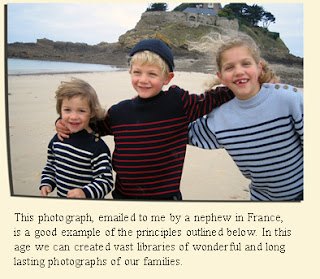
And all the people in it merely models!
by Charlie Leck
We're almost all photographers today! The digital camera has been a revolutionary household and family device. Digital cameras range from the extreme to the extremely simple. They take very good to spectacular photographs. Instead of worrying about how much film we have, we can shoot photos by the hundreds and hundreds and delete the bad ones as we go along. With modestly priced computer software programs we can enhance, correct and improve our photos with ease. If we are willing to use a little patience and time, we can archive our photographs to last for many generations to come.
So why are we still getting so many very awful digital photographs?
I have lots of dear friends and members of my family who want to be better digital photographers, but they don't want to take the time to go to classes and learn some of the principles. I feel the same way. I have too many other wonderful things to do; yet I want my photographs to be something about which I can be proud.
Enter Rick Sammon!
Rick Sammon is an extraordinary photographer. One can find hundreds and hundreds – thousands and thousands – of these guys (and gals) on the World Wide Web. Their photographs will dazzle you and leave you in envious rapture. I have visited more of these web sites than I care to admit. I've found none more comfortable than the home of Rick Sammon and, if you want to improve your work with a digital camera, I recommend it to you without reservation. But, without going to the site, I can summarize for you four of Rick's rules of photography that will immediately make you a better digital photographer. These tips will improve your work whether you are shooting with a mighty SLR or a simple, compact beauty! Here they are.
(1) FILL THE FRAME! One of the biggest mistakes many amateur photographers make is that they allow too much of the background – often uninteresting and boring – into the photograph. They stand miles away from the subject and present us with an image of Aunt Mable that takes up about one-fifth of the photo frame and she is surrounded by cars in the Walmart parking lot. Instead, move in and fill the frame with Aunt Mable if she is your subject. Did you mean to include that that 1999 Lexus with the rusted front fender and the sign instructing us to return our carts to that particular spot? Come-on! Of course you didn't. It would take only a second to jog forward and FILL THE FRAME with Aunt Margaret (with perhaps only a glimpse of the big W on the Walmart sign). Remember, always FILL THE FRAME.
(2) SHOOT TIGHT! If you want maximum sharpness in your photo, shoot it up as tight as you can. If you're downtown in New York City and you want to shoot a photograph of the Statue of Liberty, get up as tight as you can on her. You are not photographing the harbor, right? You're photographing the famous lady? Get the lady in your photograph and, perhaps, the benches in Battery Park. If you do mean to photograph her and the entire harbor, pay attention to tip #4.
These are not complicated rules we're talking about here, but we are always violating them. My wonderful wife is always shooting photographs of horses that she wants me to process. The photographs are always of the out-buildings on the farm, the loyal assistant who is holding the horse and the trash cans behind the barn. By the time I've cropped out all the surrounding unwanted filler, we have very little resolution left in the photograph. It isn't so difficult, SHOOT TIGHT. You want a photograph of your first grandchild. Get up close and get a photograph of her. I'm not interested in the stop sign behind her.
(3) SEE EYE TO EYE! This one is pretty crucial. I love to get photographs of my grandkids. Don't take them from your position as a 6 foot 8 inch uncle. That little kid is barely 2 feet tall. Somehow, make the effort to get down to her level. Let me see a photograph of my little sweet heart as she really looks. Forget the bird's eye views. And please, it's the same for photographs of pets. Don't shoot pictures of your pets from 5 feet above them. Make an effort to get eye to eye. This is one of the primary rules of photography and makes a world of difference.
(4) DEAD CENTER IS DEADLY! You bet, Rick. Thanks for the reminder. If you are going to include some background in your shot, don't always make your subject the dead-center object in the picture. The photograph will turn out much more interestingly if the subject is slightly off center or even off to the side in the total presentation. Remember though to get your focus set on the subject and then move the camera so that subject is off to the side.
Oh, what difference does it make? Well, if you're sending me photographs of the ones I love, none whatsoever. I still enjoy seeing their beautiful, smiling faces. If you want to give them a little more lasting jazz, take the above tips from Rick Sammon to heart.
All the ideas presented above are completely and unabashedly stolen from the fabulous photographer, Rick Sammon.

I enjoyed reading this post since, as you may already know, I enjoy photography immensely! I believe you told me you were into horse racing... here are my photos from the Breeders Cup. It looks like I used some of Mr. Sammons techniques without knowing it!
ReplyDeleteThis particular photo is a good example of having the subject off center